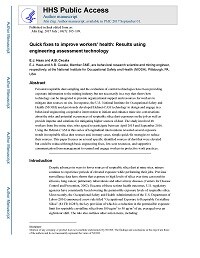Mining Publication: Quick Fixes to Improve Workers� Health: Results Using Engineering Assessment Technology
Original creation date: July 2017
Authors: E Haas, A Cecala
Personal respirable dust sampling and the evaluation of control technologies have been providing exposure information to the mining industry but not necessarily in a way that shows how technology can be integrated to provide organizational support and resources for workers to mitigate dust sources on site. In response, the U.S. National Institute for Occupational Safety and Health (NIOSH) used previously developed Helmet-CAM technology to design and engage in a behavioral/engineering cooperative intervention to initiate and enhance mine site conversations about the risks and potential occurrences of respirable silica dust exposures on the job as well as provide impetus and solutions for mitigating higher sources of dust. The study involved 48 workers from five mine sites, who agreed to participate between April 2015 and September 2016. Using the Helmet-CAM in this series of longitudinal interventions revealed several exposure trends in respirable silica dust sources and, in many cases, simple quick-fix strategies to reduce their sources. This paper focuses on several specific identified sources of dust that were elevated but could be reduced through basic engineering fixes, low-cost resources, and supportive communication from management to remind and engage workers in protective work practices.

- Benchmarking Longwall Dust Control Technology and Practices
- Dust Underfoot: Enclosed Cab Floor Heaters Can Significantly Increase Operator's Respirable Dust Exposure
- Evaluation of the Approach to Respirable Quartz Exposure Control in U.S. Coal Mines
- Improving Silica Dust Control Through Targeted Research
- Laboratory Testing To Quantify Dust Entrainment During Shield Advance
- Lowering Respirable Dust at an Iron Ore Concentrator Plant Through Improved Ventilation Practices
- Status of a Tapered Element, Oscillation Microbalance-Based Continuous Respirable Coal Mine Dust Monitor
- Technology News 447 - Dust Collector Discharge Shroud Reduces Dust Exposure to Drill Operators at Surface Coal Mines
- Technology News 486 - Floor Heaters Can Increase Operator's Dust Exposure in Enclosed Cabs
- Testing and Evaluation of an Inflatable Temporary Ventilation Control Device